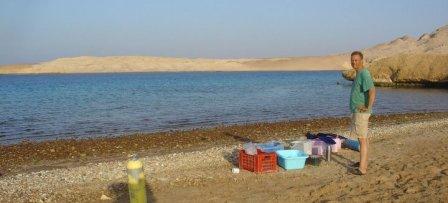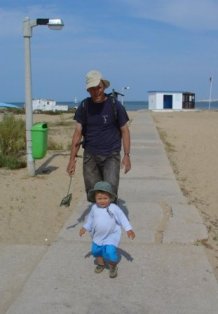Ros Albert

research interest
The goal of my research is to understand how central and peripheral
mechanisms interact in order to tune the individual behaviour to the
environment the animal is subjected to. The approach I have used in
this research is a mixture of field observations and experimental
manipulation, involving hormonal and immunological challenges.
Causation of cleaning mutualism
The aim of this project is to study to what extend the beneficial and
costly interactions of cleaner wrasses and their clients interact with
endocrine and immune mechanisms. This will provide insight into the
effect of cleaner species on the stability of the reef community, and
on how the mutual relationship between cleaners and clients is
evolved.
In order to understand how client species benefit from visiting cleaner
wrasses it is important not only to measure the effect of these visits
on ecto-parasites but also to measure whether visits influence overall
stress and health status of the client species. Part of these effects
might not be directly affected by the feeding/cheating behaviour of the
cleaner wrasses but also on the tactile stimulation these give to their
clients (Bshary and Würth 2001). Studying the effect of cleaner wrasses
on their clients provides insight into the effect of these species on the
stability of the reef community, and on how the mutual relationship
between cleaners and clients is evolved.
Previous studies showed that communities with access to cleaner wrasses
have less ectoparasites and a lower cortisol response to an elevated
stressor than communities without access to cleaner wrasses. This might
indicate lower wellbeing in reef communities with-out access to cleaners
and thereby emphasizes the importance of the cleaning wrasse for the reef
ecosystem. However, by presenting their bodies to be cleaned from parasites,
these clients also provide cleaners to have easy access to their skin and
mucus which is a more nutritive food source than the parasites. Some cleaner
fish species have been found to parasite on this extra food source, thereby
lowering the benefit for clients to visit these species.
Current students:
Meghann Meyer: Interaction between immunocompetence
and social behaviour in surgeon fish;
Jeanne Lusa: Between species comparison of the effect of
cleaning on "client" immunocompetence and endocrinology.
Data collection:
Ras Mohammed National Park, Egypt;
Lizard island, Australia.

Further studies will focus on the effect of stress hormones on client
behaviour and on the effects of manipulating the access to cleaners.
Hormonal regulation of Alternative Reproductive Tactics
(combtooth blennies)
The trade-off between reproduction and maintenance
Species with alternative reproductive tactics (ARTs) offer the
opportunity to analyse how behavioural and morphological traits
are tuned to produce successfully competing phenotypes within
one sex. The aim of the project was to study the role of androgens
as a tuning mechanism in such tactics found in the Azorean rock-
pool blenny and in the peacock blenny. In these species, the older
ornamented males compete for access to females by guarding a
cavity to which they attract females to spawn. Younger mature males
which are too small to compete with nest-holders attempt to "sneak"
into successful nests and release their sperm to fertilize freshly
spawned eggs. The two male tactics are commonly referred to as
parasitic and bourgeois males.
The switch between ARTs comprises an increase in the levels of the
androgen 11-ketotestosterone (KT), growth of the secondary sexual
characters and changes in sperm traits. The switch also includes
conspicuous changes in behavioural traits: bourgeois males show high
parental investment combined with territorial behaviour, whereas
parasitic males do not show these behaviours. The energetic costs of
developing these sexual traits in bourgeois males might trade-off with
other costly traits like the immune system. Androgens might play a role
in re-allocation of energy resources because they have been proposed
to be immunosuppressive
(Folstad and Karter 1992, immunocompetence handicap hypothesis).
In concordance with the expectation of an immunosuppressive effect
of high androgen levels we showed that basic measures of immuno-
competence were highest in parasitic and lowest in bourgeois males.
Furthermore, lymphocyte percentages in the blood were suppressed
after implantation of slow release implants with T but not KT in the
Azorean rock-pool blenny. However, no correlation was found between
individual levels of T or KT and lymphocytes. Thus, a trade-off between
reproductive traits associated with high androgen levels and immuno-
competence might exist at the level of alternative tactics but this might
not be explained by acute immunosuppressive effects of circulating
androgens.
Many questions remain to be analysed. For example, the functional
effects of the regulation by androgens of immunocompetence and
sexual behaviour has not been tested yet by quantifying actual
infection rates. Males incur many cuts and scratches during sexual
competition and these may be starting points for such infections.
Furthermore brains of the peacock blenny have been found to harvest
large populations of trematodes which could modulate their host's
behaviour.

The trade-off between sexual competition and parental behaviour
In maximizing reproductive success individuals face a trade-off between
parental care for their current offspring and investing in androgen
dependent sexual traits in order to produce further offspring. It has thus
been proposed that parental effort would suppress androgen levels
(correlated with the sexual traits) and vice versa. A test of this trade-off
in the Azorean rock-pool blenny and the peacock blenny did not find the
expected result: In the Azorean rock-pool blenny KT treatment did not
reduce parental care behaviours while the peacock blenny did not show
the expected negative relationship between brood size (and thus parental
care) and levels of T or KT.
Some recent studies have proposed that females may adjust their
reproductive investment based on the status of their partner. Females
of peacock blennies prefer larger ornamented males. A study in which
brood size was manipulated by swapping nests of males that were
breeding in tubes showed that female spawning rate is depending on the
number of eggs they encounter in the nest. Interestingly, the same study
showed that experimental changes in the female spawning rate were
inversely related with testosteronelevels. A month after manipulation
testosterone levels and brood size tended to return to the levels before
manipulation. Such changes suggest that testosterone plays an active
role in regulation of brood size in the nest of a parental male.
A new project is planned to study this brood size regulation in the field
(Algarve, Portugal) and includes manipulation of brood size and
androgen levels (slow release implants) in combination with
behavioural observations.

Hormonal regulation of behavioural changes during ontogeny
(black-headed gull)
Chick of the black-headed gull grow up in a dense colony in which they
are often left alone at their nest when their parents are searching for
food. Such chicks defend themselves using aggression and postural
displays that are similar to those of adult birds during territorial disputes.
The function of this territorial behaviour might be to defend a place in
the colony where they can be fed by the parents without disturbances.
Testosterone plays an important role in this early territorial behaviour
since treatment with the hormone facilitated the behaviour while
exposure to aggressive challenges increased levels of circulating
testosterone. There are however also costs of having elevated
testosterone levels in that animals treated with the hormone showed a
decrease in growth rate. Such costs might be minimized by a priming
effect of testosterone. Once animals have been exposed to testosterone
they responded behaviourally more rapidly to further exposure to the
hormone, thereby decreasing the "need" forhigh testosterone production.
In order to produce this priming effect the social context appeared to
play an important role and the mechanism includes an increase in
aromatase levels (conversion of testosterone to estradiol) in the
hypothalamus.
Chicks may use different strategies to reach the reproductive stage.
Important factors in such strategies are the rate of growth, maturation
of immune function, and the development of aggressive behaviour
(nest defence, sibling competition). To fully appreciate the consequences
of androgen regulation in the social system of young animals, both
descriptive and experimental field studies are still needed. An important
question that remains is how differences in testosterone exposure early
in life, induced by differential external conditions (nest density versus
aggressive challenges, maternal testosterone), may translate to later
individual differences in competitive abilities.
| since 2008 | Post-Doc with Prof. Redouan Bshary Behavioural Ecology Université de Neuchâtel, Switzerland |
| 1999-2008 | Post-Doc |
| 1991-1997 | PhD-thesis with Prof. Jaap Kruijt, University of Groningen, the Netherlands and Prof. Jaap Koolhaas, University of Groningen, the Netherlands Mentor: Prof Ton Groothuis, University of Groningen, the Netherlands |
Ros AFH, Vullioud P & Bshary R (2012)
Treatment with the glucocorticoid antagonist RU486 reduces cooperative cleaning
visits of a common reef fish, the lined bristletooth.
Hormones and Behavior 61, 37-43.
Ros A, Lusa J, Meyer M, Soares M, Oliveir R, Brossard M & Bshary R. (2011)
Does access to the bluestreak cleaner wrasse Labroides dimidiatus affect
indicators of stress and health in resident reef fishes in the Red Sea?
- Hormones and Behavior 59, 151-158.
Leong H, Ros AFH & Oliveira RF. (2009)
Effects of common stressors on acivity, metabolic rae and cortisol in a
cichlid fish, Oreochromis mossambicus.
- Journal of Fish Biology 74, 1549-1561
Oliveira RF, Gonçalves D & Ros A (2009)
Evolution and development of alternative reproductive tactics in blennies.
- In: R. Patzner, P. Hastings, E.J. Gonçalves & B.G. Kapoor (eds.),
The Biology of Blennies, Science Publishers Inc., Enfield, N.H
Ros AFH, Correia M, Wingfield JC & Oliveia RF (2009 )
Mounting an immun response correlates with decreased androgen levels
in male Peafowl, Pavo cristatus.
- Journal of Ethology 27, 209-214
Ros AFH & Oliveira RF. (2009)
Androgens and immune function in male alternative reproductive
morphotypes of the peacock blenny, Salaria pavo.
-Ethology 27, 209-214.
Regulation of broodsize and androgen levels in a teleost species with
exclusive male parental care.
- Animal Behaviour 78, 25-33
Experience modulates both aromatase activity and the sensitivity of agonistic
behaviour to testosterone in black-headed gulls.
- Physiology & Behavior 97, 30-35.
Immune activation suppresses plasma testosterone level; A meta-analysis.
- Biology Letters 4, 741-744.
Social context may affect urinary excretion of 11-ketotestosterone in African cichlids.
- Behaviour 145, 1367-1388.
Hormones and alternative reproductive tactics in vertebrates.
- IN Alternative Reproductive Tactics - An Integrative Approach. R.F. Oliveira, M.
Taborsky & H.J. Brockmann (eds.). Cambridge University Press.
Patterns of testosterone responsiveness and immunity in relation to
competitive behaviour in chicks.
- Hormones & Behavior 54, 234-237.
Metabolic costs of aggressive behaviour in the Siamese fighting fish,
Betta splendens.
- Aggressive Behavior 32, 474-480.
Aggressive behaviour and energy metabolism in a cichlid fish,
Oreochromis mossambicus.
- Physiology & Behavior 89, 164-70.
Alternative male reproductive tactics and the immunocompetence
handicap in the Azorean rock pool blenny, Parablennius parvicornis.
- Proceedings of the Royal Society of London B 273, 901-909.
Regulation of immunocompetence by different androgen metabolites
in a blenny with alternative reproductive tactics.
- Journal of Experimental Zoology 305A, 986-994.
The hormonal control of begging and early aggressive behavior:
Experiments in black-headed gull chicks.
- Hormones & Behavior 48:207-215.
Intra-sexual variation in male reproduction in teleost fish: a comparative approach.
- Hormones & Behavior 48:430-439.
Androgen levels and energy metabolism in Oreochromis mossambicus.
- Journal of Fish Biology 65:895-905.
The role of androgens in the trade-off between territorial and parental behavior
in the Azorean rock-pool blenny, Parablennius parvicornis.
- Hormones & Behavior 46:491-497.
Endocrine correlates of intra-specific variation in the mating system of the
St. Peter's fish (Sarotherodon galilaeus).
- Hormones & Behavior 44:365-73.
Mate choice in the Galilee St. Peter's fish, Sarotherodon galilaeus.
- Behaviour 140:1173-1188.
Social stimuli, testosterone, and aggression in gull chicks: support
for the challenge hypothesis.
- Hormones & Behavior 41:334-342.
Androgens and mating systems in fish: intra- and inter-specific analyses.
- In: H.J.Th. Goos, R.K. Rastogi, H. Vaudry & R. Pierantoni (eds). Perspectives
in Comparative Endocrinology: Unity and Diversity. Medimond Inc. pp 985-993.
The interaction between organizational and activational effects of testosterone
in the control of early aggression in birds: a comment to Sasvári, Hegyi & Péczeli.
- Ethology 107:851-853.
Effects of testosterone on growth, plumage pigmentation, and mortality
in black-headed gull chicks.
-IBIS 141:451-459, 1999.
The relation among gonadal steroids, immunocompetence, body mass, and behavior
in young black-headed gulls.
-The American Naturalist 150:201-219, 1997.
Testing the immunocompetence handicap in African cichlids:
negative feedback of immunity on HPG axis Sarotherodon galilaeus.

E-mail:
albert.ros@unine.ch
room: D 127
adresse:
Université de Neuchâtel
UniMail
Institut de Biologie
Eco-Ethologie
Rue Emile-Argand 11
CH-2000 Neuchâtel
Tel. +41 32 718 30 04
Fax +41 32 718 30 01
personal webpage:
http://afhros.googlepages.com






